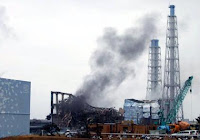 |
| Each red dot above represents a nuclear power station usually with several reactors. |
If I were a believer in conspiracy theories (I'm not), I might suggest that the entire global warming crisis was concocted to revive a moribund nuclear industry. Why would I say that? The nuclear power industry received body blows a generation ago after
Three-Mile-Island and
Chernobyl. The fear associated with those events justifiably curtailed the building of nuclear power stations worldwide. That fear has since been replaced by the fear of global warming consequences, and of course nuclear power stations don't produce greenhouse gases. Unfortunately we have been reminded that nuclear power stations do produce something besides electricity.
As I write this,
a radiation cloud is still wafting over
Fukushima Prefecture and surrounding regions in Japan and out to sea. The population of Northeastern Japan has endured a magnitude 9.0 earthquake followed by a very destructive Tsunami, followed by a nuclear accident. "
Accident" does not seem adequate, this was an accident that was waiting to happen, it was just a matter of time. The event was almost as predictable as earthquakes in Japan; they happen, they happen often, and in a country that has 55 commercial nuclear reactors (third largest number on earth) an earthquake related nuclear disaster was almost predestined -
Murphy's Law.
In the radiation cloud are
radioisotopes like
Xenon and
Iodine each with a relatively short
half-life, and
Caesium, with a half-life of just over 30 years. The dispersion of this cloud may be visualized on this
website.
For those of us who live in Eastern North America, where there are many, many nuclear reactors (see the map above), you may feel safe that magnitude 9.0 earthquakes and tsunamis are very unlikely. The simple truth about the Fukushima disaster is that the partial core-meltdowns (or worse, it's not over yet) were caused by an interruption in the cooling of these reactors. The cooling pumps stopped because of a power outage and an inability to restart the pumps due to the tsunami etc. The back-up systems had failed, first the generators then the batteries, the power station was in a blackout, which continues on 4 of the 6 reactors at this writing.
Can blackouts happen here? Absolutely! On the afternoon of
Aug. 14th, 2003 a major blackout caused the automatic rapid
shutdown of 9 US reactors and 7 reactors in Ontario (see Chapter 8, pg. 111 in that report), all of them operating at high power levels because of the heatwave in the region on that day. Fortunately for us, the cooling systems of these reactors were maintained, but the reactors in the Toronto area were offline until sometime between Aug. 22 and 25, more than a week later. This had significant economic consequences to Ontario and the region. Tragically the situation in Japan is offering us a glimpse, a lesson, at possible futures.
My purpose here, is not to scare anyone, the levels of radiation in Japan are relatively low, and you may do your own assessment of that using this
radiation dose chart online from this
blogpost. My purpose is to continue a
discussion on the use of nuclear energy. There are at least 104 commercial nuclear reactors on 64 sites in the United States, with an additional 34 research reactors at Universities across the US, and an estimated 272 military reactors. In Canada there are at least 23 commercial reactors (
plus two are planned), and 19 research reactors at research centres and Universities across Canada.
Since 1952, when the first nuclear reactor came online, their have been at least
100 significant nuclear accidents around the world. While fatalities have been low, that real number is difficult to calculate given the slow rate at which radiation-related health problems occur. Look at the map of nuclear power stations above again. Do you live near one of those red dots? Probably, even if you don't, a radiation cloud from an accident can be carried quite a distance. If you live in Ontario where prevailing winds from the west and southwest are common, well, you can see what I mean? So what kind of pollution would you prefer, the radioactive kind, or just plain old air pollution and carbon dioxide (which is not a pollutant really)? I know what I prefer.
See part 2 soon.


















